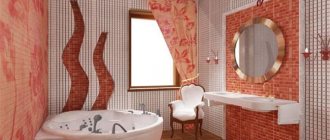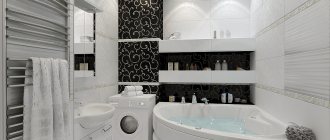Renovations in new buildings differ significantly from renovations carried out in old buildings. To achieve the best result of renovating a bathroom and toilet in a new building, it is important to take into account the shrinkage of new buildings, as well as think in advance about the layout that is convenient for you, the ergonomics of the bathroom, the design and the most suitable materials for wet rooms. First, let’s take a closer look at the “+” and “-” repairs in new buildings:
- The first plus is that renovations can be started from scratch, unlike houses that were built several decades ago (for example, in the same “Stalin” and “Khrushchev” buildings), where, unlike new buildings, there is a need to dismantle old coatings, pipes, furniture, etc.
- Unlike the crooked brick walls of Khrushchev or Stalinist houses, in new buildings the walls are straighter and the plaster required for leveling is half as much.
- The opportunity to build walls inside an apartment from scratch, for example, to build a bathroom of the size that the owner of a new home wants for further comfortable living! You can completely change the interior and ergonomics of the bathroom, install a large bathtub at the same time and additionally install a toilet or shower. There are more opportunities to implement design ideas!
Of course, renovating a bathroom and toilet in new houses has its own difficulties and “-”, such as:
For example: the first years of a new building shrink, which is why cracks may appear in the plaster, changes in the geometry of floor coverings occur, etc. New buildings tolerate shrinkage differently! For example, shrinkage in block, monolithic or brick-monolithic houses is stronger than in panel houses. Shrinkage time is on average from 2 to 5 years.- Often in new buildings the walls of the bathroom (bathroom and toilet) have already been built, and are often built of concrete, which complicates repairs, or rather such work as: chiselling in concrete walls for laying water and sewer pipes, new wiring and sockets.
Bathroom renovation and features of new buildings
You can renovate a bathroom in a new building with your own hands, but before you start working. It is worth considering some of the features and nuances of the room with which you will be working. Let's look at these details in more detail:
- In the new room, the walls may not be level enough, for this reason you will have to level the walls in the bathroom. Moreover, such work may also be needed for the ceiling, as well as for the floor. To reduce work time, it is possible to use suspended ceilings, then the surface will not have to be leveled.
- Before starting work on finishing the premises, experts recommend performing work that involves laying pipes and electrical lines. At the same stage, heating is carried out.
- There is a significant advantage of the new building. It lies in the fact that all wiring and communications will be completely new.
- The owner can also choose the design he would like. After all, repair work starts from scratch.
- Since the renovation begins in a completely new room. The technician will not have to waste time removing old floor or wall coverings.
Professional turnkey renovation of bathrooms and toilets
Of course, you can try to do renovations in the bathroom and toilet in a new building yourself. However, this will take a lot of time and it is not a fact that all the work will be carried out at the proper level. In this sense, the help of our professionals who have sufficient experience and relevant knowledge will be indispensable. They will be able to carry out repairs in the bathroom taking into account the upcoming shrinkage of the house. All work we carry out is guaranteed for 3 years! The turnkey renovation time for a bathroom and toilet is from 2 to 4 weeks, depending on the size of the room and the amount of work! Below is a list of turnkey works in the bathroom and toilet:
- Dismantling works;
- Primer of walls and floors;
- Leveling walls and floors according to the beacons;
- Installation of a plumbing duct in the toilet;
- Waterproofing in the bathroom;
- Installation and connection of a cast iron or acrylic bathtub;
- Installation of fans;
- Installation of water pipes and sewerage;
- Electrical installation work (replacement of electrical wiring, installation of switches, sockets and lamps);
- Laying tiles on walls and floors;
- Installation of slatted or suspended ceilings;
- Installation of roller shutters, overhead hatch or invisible hatch in the sanitary closet;
- Installation and connection of a bathtub, sink with cabinet, toilet, washing machine, sink faucet, bathtub faucet or installation of a shower system;
- Installation of 2 doors;
- Installation of accessories;
- Cleaning and removing trash up to the stairwell.
Types of finishing
Work begins with leveling the walls and ceiling; this is considered rough preparation of the room. In some cases, at the preparation stage, the owner can think through the layout of the bathroom. Make some adjustments to it if necessary.
Once the rough work is completed. The decoration of the room begins with the help of finishing materials. At the same stage, the installation of the required equipment and plumbing, the choice of lighting and waterproofing of the floor covering are carried out.
Rough finishing of the room during the renovation of bathrooms and toilets
The stages of renovating a bathroom in a new building begin with preparatory work. They include leveling the walls and other surfaces in the room, if necessary.
When an apartment is rented with rough finishing. The owner should prepare for a long and difficult bathroom renovation. At this stage, you should make a layout of the room, and if necessary, make some adjustments to it.
A lot of time is spent on leveling the walls, since they can have height differences from 7 to 15 cm. A sand-cement screed is required on the floor.
Finishing the room during a bathroom renovation in a new building
At this stage, the choice of materials for finishing the bathroom takes place; the master must plaster the walls, make a screed on the floor and decorate it with a coating.
The simplest plumbing fixtures are installed in the room. You should choose suitable lighting for the bathroom, but all this is considered basic.
When the base is ready, waterproofing of the floor begins, higher quality plumbing is installed, and the walls and floor are also finished. When the final finishing is completed, household appliances are installed in the room.
What should you consider when preparing for renovation work?
Cracks in the cladding during shrinkage of a new house
Considering the fact that the house was recently built, you should not immediately undertake expensive bathroom renovations in a new building. It is much more relevant to purchase inexpensive tiles and stick them on the walls and floor. As for the ceiling, decorative panels are ideal for it. This approach is due to the slight shrinkage of the structure. Depending on the time that has passed since the foundation was poured, shrinkage can take from 1 to 3 years.
If you neglect this advice, you can get extremely negative consequences. Thus, expensive tiles will begin to crack and very soon lose their attractiveness.
Among other things, new residents can expect such surprises as “flooding” by their upstairs neighbors, as well as leaks in their own apartment. In the first case, you will have to urgently repair the ceiling. As for the second option, it will force an urgent opening of the floor covering and repair of communications if inspection hatches were not provided.
Tile texture - wallpaper, brick, what to choose?
Modern design elements
Today you can choose a variety of interior designs for the bathroom, and thanks to modern technologies, the room becomes functional and comfortable.
It is worth describing the most popular new items that are used to decorate a bathroom:
- Rectangular bathroom. Now we are not talking about an ordinary bathroom, but about a product with wooden cladding. You can also purchase more budget models, in which the cladding will be made of material that imitates wood.
- Bathroom built into the podium. This is a rather original design option for the product, and it is advisable to use a large podium. Of course, this design is only suitable for a large room. The bathroom itself should be round or rectangular.
- Rectangular sanitary ware. This year, it is in fashion to decorate a room using rectangular sanitary ware, and it is advisable to choose a white toilet and sink.
- Hanging toilets and bedside tables. Such designs will complement the interior of the bathroom, and can also become part of the disguise of communications and wires.
In addition, it should be noted the lighting features of the bathroom; the finished appearance of the room after renovation depends on this. At the peak of popularity are unusual options for lighting systems, these include lighting of mirrors and niches, as well as built-in lighting on the floor.
Additional lighting makes the design unusual and functional. Indoors, lamps and bright lighting are usually not used; designers prefer spotlights.
Replacement of plumbing
If we are talking about a turnkey renovation, then the plumbing must also be updated. The old one must be removed before the ceiling, floor and walls are installed.
When thinking about replacing a bathtub, many succumb to trends and try to replace it with a shower stall. However, you should weigh everything carefully. After all, the bathroom is actually capable of performing the functions of a cabin (you can take a shower while standing), but the shower will not allow you to comfortably lie down in it. Therefore, professionals recommend that if the size of the room allows, it is better to install a bathtub; a shower cabin should be used either as an addition, or in the case of very small room dimensions.
It is also recommended to use a separate washbasin in the bathroom. This means that in some cases the owners of the premises decide not to install this element, citing the fact that they can wash their hands above the bathtub. However, from the point of view of convenience and correct operation, it is still worth installing a washbasin, and with a separate mixer.
Selection and purchase of new plumbing fixtures and finishing materials
After purchasing an apartment in a new building, owners often begin to wonder where to begin renovation work. First you need to select the required finishing materials, as well as new plumbing.
This stage is very important, but first you will have to think through the design of the room to the smallest detail, and in addition, decide on the models of plumbing. Before you go to the store for finishing materials, you should calculate how many of them will be needed to finish the bathroom.
Before purchasing sanitary ware, you should check their exact dimensions so that they fit exactly in the bathroom. It is better to purchase finishing materials and tools in one building materials store.
It is better to purchase what is required in a slightly larger volume, also taking into account possible waste. This will ultimately help avoid problems with finding missing material.
What does it mean?
In essence, “turnkey” means that the space is completely ready for use, all that remains is to open the door and use it, in this case the bathroom. Thus, when we say “turnkey”, we mean a fully completed high-class renovation, as they say, European-quality renovation - in the photo.
Therefore, it would be correct to describe all the stages that allow you to achieve such outstanding results in repairs:
- water supply and sewerage;
- laying cables for sockets and lighting;
- performing waterproofing and screeding;
- surface preparation;
- arrangement of the ceiling, floor and walls;
- door replacement;
- replacement of plumbing;
- arrangement of furniture and other elements.
Let's figure out what happens at each stage. And, of course, we note that most operations should be carried out wearing personal protective equipment: goggles, hats, gloves, special clothing and shoes, and a respirator. There is no need to underestimate each item, since its function is to protect health, and possibly life. Therefore, use is highly recommended.
Laying pipes, electrical wiring and other communications
Many craftsmen know how important it is to choose suitable pipes, since the material from which they are made plays a big role. Typically, polypropylene pipes are used; this material is quite durable and can last longer.
When it is necessary to install pipes in the bathroom, they are usually hidden in the walls so that they do not spoil the appearance of the room after finishing. Grooves are made in the walls, and pipes are laid in them, and communications are closed from above using tiles.
The process of laying pipes is very important; it must be done correctly to avoid blockages and poor pressure. If the owner has never done this himself, he should seek professional help. The craftsmen will also be able to install a filter and counters, if necessary.
When carrying out electrical wiring, first a plan is drawn up that indicates its location. Based on the completed project, they begin to lay the wires.
Services and what is useful to know about them
Articles/Features of bathroom renovations
When preparing for a bathroom renovation, you need to clearly understand its features.
Firstly, in the bathroom, hot and cold water communications, drainage of water into the sewer and electrical wiring for lighting sources and a washing machine are concentrated in a small space. The bathroom also has a cold water supply to the washing machine and drains waste water from it. Therefore, in the bathroom there are specific safety requirements for the proximity of water and electricity. You should also consider the possibility of high humidity in the bathroom. Therefore, all communications must be routed safely and not spoil the overall design of the bathroom.
The second feature of bathroom renovation is that it must be carried out as quickly as possible. This is explained by the fact that during the renovation of this premises, the residents of the apartment experience severe inconvenience every day, since each family member has to use the bathroom at least 2 times a day. The situation is aggravated if small children or elderly people also live in the apartment.
The importance of the preparation phase
Experience shows that the more detailed you think about the plan for the entire repair at the preparation stage:
- the faster and more organized it will be: there will be no unnecessary pauses associated with organizing repair work, as well as errors associated with the purchase of building materials, plumbing equipment and electrical equipment;
- the more accurately you can calculate in advance the cost of the entire bathroom renovation, taking into account the cost of the work.
Sequence of your actions
First of all, you need to decide whether to renovate the bathroom yourself or hire specialists.
In the first case, you can save a lot, since you don’t have to pay for the work of hired workers. This is certainly very tempting if you are capable of it. But we must understand that here we can trace the exchange of the amount of money for time. In addition, the entire organization of bathroom renovations and purchases falls on you. In order for the renovation to progress quickly, you must have enough free time every day. If you work in the evenings and on weekends, the renovation will drag on for months and it may happen that your loved ones will get tired of the renovation before you finish it.
Or maybe it’s easier and faster to make money at your main job, in which you are a professional, and entrust bathroom renovations to people who do such renovations every day and have practical experience in this work? It's up to you and only you to decide.
Pros and cons of a turnkey bathroom renovation
Currently, it has become a fashionable trend to entrust the work to specialists who do the entire range of work themselves, and all you have to do is accept the work and make the final payment.
How is this convenient for you? It is convenient because in this case you are dealing with only one person (crew). You do not need to separately look for a specialist in tiling, ceiling finishing, plumbing and electrician. You do not need to become a foreman for your repairs and organize the work of each specialist individually. Here it is enough to be the main supervisor of the work and timely voice your complaints, if any, to only one person who is responsible for your repairs as a whole.
On the other hand, a turnkey bathroom renovation requires the owner or hostess to have a clear understanding of the actual scope of work being performed, which sometimes conflicts with the opinion of the work performers who are trying to do not much work for unreasonably large amounts of money. Therefore, basic literacy of the owners during the period of preparation for concluding a contract for bathroom renovation can prevent unreasonable overestimation of the cost of work on the part of the proposed performers.
The only thing you can save on if you entrust bathroom renovation to specialists is dismantling old equipment and dismantling the lining materials of the floor, walls and ceiling of the bathroom. You can do this yourself, but the work is dusty. Here, as people say, “breaking is not building,” but you can save money (it even worked out in rhyme).
How to calculate the cost of a bathroom renovation
If you decide to entrust your bathroom renovation to specialists, then before hiring them, you should have at least a rough idea of how much all the materials plus the necessary equipment will cost and how much the work itself will cost. Then you will be able to more reasonably negotiate (bargain) the cost of repairs with the proposed contractor before concluding the relevant contract.
But to do this, you need to clearly know what you want to have as a result of a bathroom renovation and what is currently available.
It is convenient to explain the cost calculation mechanism using a specific example. Let's take a standard case.
Let's assume that before the renovation, your bathroom has a bathtub and a washbasin with mixers, the floor and walls are tiled, and the ceiling is painted with moisture-resistant paint. There is an automatic washing machine. The cold water supply and drainage are not permanent; there are the necessary shelves and one lamp. The condition of the bathtub, washbasin and tiles is quite satisfactory.
After a bathroom renovation, you want to see - a new bathtub and vanity, a new floor and walls that are tiled with a beautiful set of modern tiles, a new suspended ceiling with built-in lights, a new ventilation grill, new wall shelves, a permanent connection for the washing machine. In this case, there must be a full understanding that at the same time the pipes and riser should be replaced, since you want to do the repair well and for a long time.
When planning the final result, you should also take into account the “repair effect”, which can be briefly formulated as follows. What looks good before renovation, after renovation begins to catch your eye and spoil the overall impression. For example, if now it seems to you that your bathtub can be saved, then try to imagine how a bathtub that has been used for ten years will look against the background of everything new: walls, floor and ceiling? Introduced? Of course, it will be conspicuous and aggressively stand out against the background of everything new and be perceived as something foreign. Now decide whether to leave it or not? This also applies to the rest of the bathroom.
Next, you should at least sketch out a plan of the bathroom, having first measured it. The locations of the bathtub, washbasin and washing machine are shown on the scale plan. Then a diagram of the cold and hot water supply to the bathtub, washbasin and washing machine is applied to the plan, including all pipe bends, a diagram of the drainage of water from the bathtub, washbasin and washing machine into the sewer, as well as a diagram of the electrical wiring to the location of the lamps and the washing machine and other repair elements. It is necessary to decide what finishing materials the floor, walls and ceiling will be made of. It is important that all bathroom elements, plumbing fixtures and surface coverings match the same style. When selecting materials and equipment for the bathroom, it should be taken into account that they must be resistant to elevated temperatures and moisture, and electrical equipment must have a protection class of at least three.
You can draw a project according to the “from end to beginning” principle, first highlighting the key and fundamental points, and then working out the details of those elements on which you have finally decided. All this can be done in several passes. Then you will know exactly what you want to have as a result of your bathroom renovation.
Now, looking at the bathroom plan, you can calculate the required number of pipes, elements and types of their joints, and the need for electrical wires, wiring boxes and other electrical elements is also estimated.
Knowing the geometric dimensions of the bathroom will allow us to correctly calculate the exact amount of facing materials. They must be purchased with a reasonable margin for trimming and taking into account the possible replacement of some cladding elements during the operation of the bathroom after renovation.
Then, in the same way, the need for the quantity of everything else that you put on the plan is calculated.
Just remember to estimate the degree of curvature of your bathroom walls, in order to take into account materials for leveling them, if necessary. Also decide whether or not to install a waterproofing screed on the floor.
If you don’t know the prices, then, without leaving your home, we “shovel” the Internet. In a couple of evenings spent at the computer with a cup of tea, you will know all the market prices for the required materials and the cost of work.
Having a drawn-out project and focusing on prices, you can calculate the cost of a bathroom renovation with an accuracy of 10 percent, taking into account the cost of performing the work.
Now it will be easier for you to communicate with the proposed contractors, since you know exactly what your bathroom should look like after renovation and how much such renovation should cost.
Leveling walls, ceilings and floors
New buildings are distinguished by the fact that they require preliminary preparation of all surfaces of the room, since differences in height of the floor and walls can reach ten centimeters. To fix the problem, the technician must first screed the floor to make the surface more even.
Finishing is already done on the finished subfloor. Leveling is not difficult; you should purchase a special mixture in the store, which is diluted with water to the desired consistency.
The resulting solution is poured onto the floor and then leveled over the entire area. To make the coating even, special beacons are used.
As professionals say, it is better to use sand concrete screed, as it is durable and of high quality. Be sure to leave a little space around the edges of the screed; wiring will be done there later.
Depending on the thickness of the layer, the screed can dry from two weeks to one month, this should be taken into account. When the subfloor is prepared, a heated floor is installed on it, if necessary.
If we talk about leveling the walls, then plaster is used here. The work process is not complicated, but the markings with beacons and the rule are first prepared. Using a trowel, the mixture is applied to the surface, and when the process is completed, the big rule is established.
It is very important that there is a gap of no more than two millimeters between the rule and the wall. As soon as the solution has completely dried, putty is applied to the wall, and after the surface has dried, the wall is sanded.
Finally, the surface is covered with a primer mixture. On the rough finishing of the walls, holes are made for cables and wiring, if necessary.
Arrangement of the ceiling, floor and walls
If for the floor and walls the material most often determined is tiles, then for the ceiling there are often doubts. However, the most common option is the use of plasterboard construction - in the photo. Since we are talking about a bathroom, moisture-resistant plasterboard is used. This design allows you to get a reliable and beautiful ceiling, which can be decorated in any color with a variety of shapes. At the same time, it is convenient to install lamps in the suspended ceiling to create organic lighting.
Finishing with facing materials
At this stage, the master begins the final finishing of the room; you can lay tiles, paint surfaces, use various mixtures and much more.
First, it is recommended to tackle the ceiling; it is usually coated with emulsion paint; the coating makes the surface attractive. In addition, this paint protects the ceiling from moisture; several dozen shades of this coating can be found on sale.
If you want something more attractive and practical, you should pay attention to plastic panels or suspended ceilings.
The floor is usually laid with durable ceramic tiles, or decorated with tiles. If a bathtub is installed in the bathroom, covered with a screen, then the floor under it does not need to be decorated with material. This will significantly save time and material. Mosaics, ceramic tiles, tiles or regular paint can be used for walls.
Where to start renovating a bathroom in a new building
Bathroom in a new building: where to start renovating a bathroom and what needs to be considered?
The age-old question is where to start renovations in a new building? It's simple, start with a general assessment of the condition of your premises. And if in a bedroom, living room or children's room, as a rule, it is quite difficult to refresh the finish of the ceiling, floors and walls, then the bathroom and kitchen require a careful and thorough approach. Where to start renovating a new apartment? What are the distinctive features of renovation in a new building from renovation in a room that has been inhabited for a long time? These kinds of questions are often of interest to many consumers.
After purchasing an apartment in a new building, you should be prepared for the fact that there will be absolutely no finishing inside. An approach from this point of view will significantly reduce the cost of the premises and make it possible to decorate the area according to your own capabilities and taste.
When starting a bathroom renovation in a new building, it is very important to know the following:
- The lower the cost of the tile, the less you will feel sorry for it. Over time, the walls of the bathroom tend to “adjust” to the overall structure. As a result, microcracks appear, microcracks will certainly appear, and deformation of the tile is quite possible. That is why you need to look for a nice tile, but such that after a short time (a year or two) you can throw it in the trash without the annoyance of wasted money;
- Absolutely any house shrinks over time. As a rule, this happens for the first time in 2-3 years - this means that the selection of necessary materials must be careful;
- When installing pipes, immediately use plastic pipes. This material is perfect for any temperature. Also, it is resistant to changes in jet pressure and corrosion.
- If you have a window in the bathroom, immediately, without unnecessary worries, install a high-quality PVC profile. Such structures are resistant to dampness and stress. They are also not afraid of deformation.
It is advisable to immediately cover the ceiling with plasterboard, of course, if it suits you. All ceilings are subject to minimal deformation. An important advantage is that drywall is a very light material; it in no way weighs down the structure. Allows the ceiling to “adapt” to the structure of the entire house.
It is also worth seriously considering the following aspects:
- where is it better to place the pipeline and electrics, cut through the walls, cut out grooves;
- if necessary, where to make partitions in the bathroom;
- address the issue of lighting;
- figure out where the washing machine will be located, figure out the location of the outlet for the electrical appliances you need;
- How will the piping in the bathroom be done? Don't forget that it will also go into the kitchen;
- install a washbasin, shower (bathtub);
- check the sewerage connection;
- be sure to install everything necessary for ventilation of your bathroom;
- add hot and cold water supply.
Related posts:
In the section: Construction and repair
When buying an apartment, in a new building or a secondary home, everyone thinks about renovations to suit their taste. After all, you want to live comfortably in your new living space. Where to start renovating a new apartment?
In the section: Construction and repair
Cleanliness, freshness and good mood reign here - the bathroom is one of the favorite places in every home! But due to the abundance of moisture, it is this room that is most susceptible to destructive processes.
In the section: Construction and repair
A new building means spacious kitchens, spacious balconies, convenient layout of rooms, modern electrical wiring, a brand new sewer system and many other advantages. But in a while.
In the section: Construction and repair
Where to start renovating an apartment in a panel or monolithic building? It is necessary to know the difference in construction technology in order to make repairs “excellently” and without errors.
Where to start renovating a bathroom - competent organization of renovation work
The bathroom is one of the special rooms in your apartment, and its renovation should be approached with special attention. After all, it is here that water flows in large quantities and often; in this room there are large changes in temperature and humidity. For the correct and rational organization of finishing work, you should firmly know where to start renovating the bathroom and have an idea of the sequence of repair work.
Determining the type of repair
Bathroom renovations can be:
Unplanned. The need for spontaneous repairs may arise if an unforeseen situation arises (a pipe burst or your neighbors flooded you). If you decide to replace the bathtub, this may also entail sudden repairs (changing sewer pipes, installing other plumbing fixtures, updating tiles, etc.);
Planned repairs. Depending on the complexity and material costs, the planned repairs can be major or cosmetic. Of course, cosmetic repairs are cheaper, but such work can only be carried out if there is no fungus and the plumbing and plumbing are in good working order. Such repairs involve replacing wall and ceiling coverings, updating floors and faucets. And more serious repairs, even if not completely major ones, require thorough preparation and a serious approach.
We draw up a repair plan and determine the future design
When renovating a bathroom with your own hands and wondering where to start, you should first decide on the future design of this room. Imagine what you would like your bathroom to look like, decide on the color. Traditional colors for this room are pastel colors or a combination of two tones (for example, blue and blue, or peach and beige).
Then you need to decide what materials will be used for finishing. To decorate a bathroom, they often use:
- Tile;
- Porcelain tiles;
- Mosaic;
- Plastic panels.
Carefully inspect your plumbing fixtures and, if necessary, decide on an option to replace outdated plumbing fixtures.
Using a tape measure, measure the height, width and length of the room, and calculate its area. Determine where the plumbing fixtures will be located, because it is unlikely that you will be able to change anything after the repair.
Video: Modern bathroom design and planning
Selection and purchase of new plumbing fixtures and finishing materials
Having decided to carry out renovation work in their bathroom themselves, many owners wonder where exactly to start renovating the bathroom and go to choose new plumbing fixtures and finishing materials. Of course, this stage of repair is very important, but it should only follow after you have completely decided on the design, type of new plumbing and the amount of finishing materials needed.
Before purchasing plumbing fixtures, be sure to check their dimensions and check whether they will fit your bathroom.
It is better to purchase finishing materials and tools in one store, where you will also be offered a good discount for a wholesale purchase. Buy everything you need at once in full, so that later you don’t waste time and don’t run around looking for missing material.
Dismantling of old finishing materials and plumbing fixtures
Next, you should prepare the room directly for renovation work. It is better to dismantle the sink and bathtub during renovation, even if you do not intend to change them. Then you need to remove the old tile covering, clean the ceiling, walls and floor. If the walls in the bathroom were painted with paint, then it should be completely removed. After all, adhesive mixtures or a new layer of paint will not stick to the old coating.
Removing old tiles. Photo - tamabau.de
Laying pipes, electrical wiring and other communications
Having dismantled the old coating, you can begin to replace the pipes. In old houses, it is worth replacing, in addition to the pipes located directly in the bathroom, the main riser (in the case of a combined bathroom); and in some cases even water pipes between floors. Since old pipes can leak, which is fraught with new unplanned repairs and new costs.
At this stage of repair work, it is worth replacing the electrical wiring. Determine where electrical appliances will be located and install the required number of sockets, change the wire and switch.
Do not forget to take care of the repair and installation of ventilation, this is very important for the bath. It is best if the ventilation is forced. Today on the market there are many options for different fans for organizing forced ventilation.
Leveling walls, ceilings and floors
The scale and nature of these works depends on the condition of the surfaces. If the walls are very uneven, you will have to level them using plaster. If the walls and ceiling are fairly smooth, there is no need to use a large layer of material, and in some cases you can get by with putty. If the surface needs to be leveled a lot, then the repair may take longer.
Leveling walls with putty. Photo - www.filippo.nl
Finishing with facing materials
Now you can begin finishing the walls and ceiling: painting, laying tiles, covering with selected mixtures, etc.
An excellent option would be to cover the ceiling with emulsion paint: the ceiling looks very beautiful, moisture does not accumulate on it, and you can choose any shade. A more practical alternative would be to install plastic panels or a suspended ceiling.
If you are installing a bathtub covered with a screen, then you don’t have to tile the floor underneath it to save material.
Installation of plumbing fixtures
Plumbing fixtures are installed after all finishing work is completed, so as not to damage the new (old) plumbing during the repair process and to ensure unimpeded access to the surfaces of the room that require finishing.
Sink installation. Photo – contentfreelance.com
Installation of accessories and entrance doors
At the final stage of renovation, furniture and accessories (hooks, mirrors, lamps, etc.) are placed in the bathroom. The door is also just now being replaced. It is not worth replacing the doors earlier: they can be easily damaged during the repair process, bringing in and installing plumbing fixtures.
Now you know where to start renovating your bathroom and in what sequence to carry out the work. Therefore, you can easily cope with this difficult task, and the updated bathroom will delight you with its shine and impeccable appearance.
Video: Recommendations for repairs and savings on bathroom renovations
Repairs in a new building in stages
Have you finally received the keys to your dream apartment in a new building? You open the treasured door, and there are empty walls, a gray screed on the floor, no doors or lighting. On the one hand, this is a huge space for us to maneuver and the opportunity to organize our own space from scratch, on the other hand, there is fear of costs, worries, loss of time, and the question - where to start? Such thoughts arise in many owners of new buildings; the dream has come true - you are the owner of a brand new apartment of your own. Now we need to decide where to start repairs in a new building step by step in order to do everything correctly and avoid mistakes. We will talk about this in this article.
Renovation of a new building in stages - how to plan
Work on interior decoration and interior design should begin with careful consideration of each step. In this case, we recommend using common sense, patience, and a detailed action plan that will help you manage the job well and save time and money.
Detailed interior design should be developed at the raw room stage. It's not always as simple as it may seem. On the one hand, we know what we expect from our apartment, but we have no idea where to start arranging it. Experts offer the following work plan on how to renovate an apartment step by step in a new building.
Step-by-step repairs in a new building without finishing
- Planning the location of the walls . At this stage, you can remove unnecessary walls or build new walls or partitions. Not all partitions can interfere; you cannot demolish the load-bearing walls of the building, all types of pipes or ventilation.
- Electrical – you need to determine whether the apartment has a sufficient number of electrical outlets and whether they are all in the right places: planning additional lighting or changing its current location;
- we add light switches on the stairs - a very convenient solution in houses with a large hallway;
- additional sockets;
- planning various outlets in the kitchen, including an outlet for the dishwasher, range hood, under-cabinet lighting, and an outlet for the induction hob and oven;
- in the living room, we plan connection points for cables and places for laying the antenna cable, wired Internet, cable from the TV, while some of the cables can be hidden in the wall, and some in the baseboards.
- All this work must be completed before the final painting of the walls in the bathroom and kitchen before laying the tiles.
- installation of pipes for a dishwasher and sink in the kitchen (disguising pipes, moving connections to the right, left);
- plaster;
Contract with the contractor
It is advisable to conclude an agreement with the contractor in writing. Such a document in the event of a dispute will become the basis for compensation. It is worth discussing:
- The parties, the subject of the contract - the scope of work and the dates for their commencement and completion.
- Remuneration for performers, terms and methods of payment. You can pay according to the estimate of the planned work, or at a fixed rate - based on the agreed amount of the work estimate. The second option is more beneficial for you - the contractor cannot demand an increase in wages.
- Statement from the contractor who undertakes to perform the work in accordance with the rules and construction standards.
- Penalties if the contract is not fulfilled or is not performed improperly by one of the parties, as well as a condition on the possibility of demanding compensation for losses.
- Signatures of the parties.
The contract should indicate the amount of payment and deposit for the contractor. Enter a caveat that if he fails to comply with the terms of the contract, you may require him to pay double the deposit.
Turnkey finishing - pros and cons
In the case of turnkey interior finishing from the developer, much depends on the contract. Some developers provide flooring (laminate), interior doors, wall coverings (tiles) and plumbing, some even offer interior design.
Advantages of turnkey finishing from the developer:
- you save time while shopping;
- there is no need to search for and control performers.
Disadvantages of turnkey finishing:
- rarely does the customer agree with the quality of finishing materials and work performed;
- limited choice of performers;
- disagreements in design decisions and choice of materials.
- Apartment renovation, leveling walls
How to level walls - 2 ways Perfectly even walls in an apartment are a mandatory norm for… - Waterproofing tape for the bathroom Tape for waterproofing the bathroom /” title=”Repair of bathrooms and toilets”> Home /vse-vidyi-remonta/” title=”Useful articles”> All…
- How to replace and renovate bathroom plumbing The bathroom is a part of the house that is very difficult to furnish. This is due to the fact that…
- The procedure for renovation in a new building Stages of renovating an apartment from scratch in a new building If you have become the happy owner of an apartment in a new building,…
Installation of plumbing fixtures
Installing equipment in a new room is not difficult, the main thing is to correctly connect all the existing pipes. A certain sequence of actions can be distinguished:
- Before installing the bathtub, you should connect the siphon; a corrugated hose is best suited for this.
- When the tightness of the hose is checked, the bathroom is grounded.
- Depending on the drain, the sink can be installed on a separate pedestal or mounted in a cabinet; models mounted on walls are no less popular.
- If the bathroom is combined with a toilet, a toilet is installed. It can only be installed in a certain place where there is a sewer drain.
The toilet is also selected depending on where the drain is located. You can fix the plumbing fixtures to the wall, use hanging models, or install the toilet on the floor.
Ready premises for use - the result
If the bathroom is turnkey, it means that it has something so that the room can be used 100%. It is understood that the repairs performed comply with all modern requirements and main trends, including design.
This approach allows homeowners not to interfere in the process, but only pay for a completely finished project that can be implemented within a certain period of time. This means no nerves or rework – the result will be obvious and pleasant.
Installation of accessories and entrance doors
This process begins when all renovation work on the premises is completed. The owner can install a suitable door in the room, and then arrange the required furniture and accessories in the bathroom.
Accessories include mirrors, lights and lamps, various hooks. It is not recommended to install the door before the repair is completed, since during roughing and finishing work there is a high probability of damaging it.
The relationship between repairs and the features of a new building
It is not recommended to immediately decorate a newly built building for many years to come with expensive materials. The first 12-36 months after completion of construction work are spent on shrinkage and drying of the foundation and the entire structure. As this period of time passes, collateral damage may occur: expensive coatings sometimes crack, fall off, and lose their decorative qualities.
At the initial repair stage, there is a risk of flooding by neighbors or neighbours, which will entail the need to remove the ceiling or floor covering.
The advantages of finishing work in new buildings are:
- no need to dismantle the previous coating;
- no need to remove construction waste;
- wires and pipes are laid at the discretion of the owner;
- wide range of bathroom designs.
There are also disadvantages when working with this type of building:
- often additional leveling of the surface from small irregularities and voids is required;
- eliminating differences in walls and ceilings;
- first you need to lay communication lines, since later you will have to remove the decorative trim, lay drainage, water supply, electricity and re-finish everything.
A new building requires mandatory rough finishing, without which finishing will be pointless.
After this stage, you can begin to carry out engineering and technical communications, the location of which must first be carefully considered. The required amount of material, construction budget expenditure, and time costs will directly depend on the location.
Now they are starting to arrange grounding, drainage, and water supply. Only then is it possible to install the ventilation system and sockets.
Next, decorative finishing of the room is carried out, which ends with the arrangement of furniture, appliances, and plumbing fixtures.









